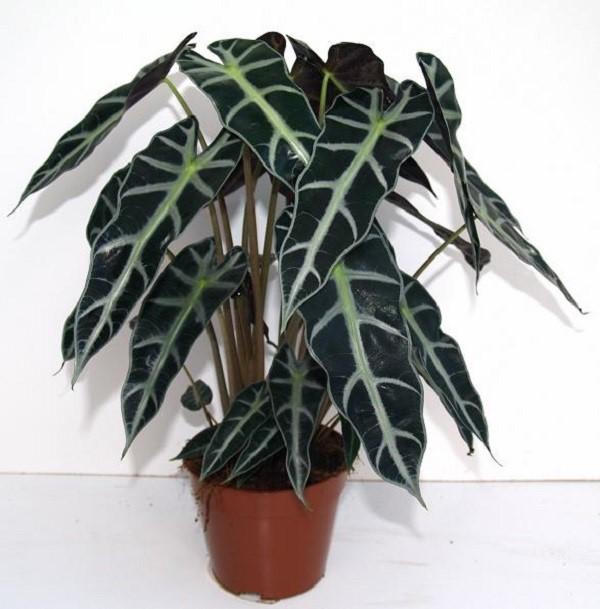Large but fragile beauty alokazia polly
 One of the most decorative types of alocasia is the Polly variety. This is one of the hybrids of Sander's alocasia, a moderately tall bush, with proper care it grows up to 70 cm in height. The main decoration of the plant is large rich green leaves up to 0.5 m long and about 20 cm wide. They grow on short, but plump petioles, and under the rays of light they effectively shine with a metallic sheen. The edges of the deciduous plates are formed in the form of denticles; towards the end the leaf is sharpened, and light wide veins are clearly delineated throughout the plate.
One of the most decorative types of alocasia is the Polly variety. This is one of the hybrids of Sander's alocasia, a moderately tall bush, with proper care it grows up to 70 cm in height. The main decoration of the plant is large rich green leaves up to 0.5 m long and about 20 cm wide. They grow on short, but plump petioles, and under the rays of light they effectively shine with a metallic sheen. The edges of the deciduous plates are formed in the form of denticles; towards the end the leaf is sharpened, and light wide veins are clearly delineated throughout the plate.
The leaves of the plant are very large, but delicate, therefore, during the unrolling of the tube with the leaf, it should not be touched, otherwise "prints" will remain.
The bush can have 20 to 30 leaves, however, when new leaves come out, the old ones die off. Alocasia Polly differs from other arum species by its more frequent flowering.
To preserve the decorative appearance of the leaves, some growers remove the inflorescences so that they do not take away the plant's strength.
Despite the rather capricious nature, it is not very difficult to grow a flower. In this case, the "only" condition of maintenance will be compliance with all the requirements that alocasia makes to its owner or mistress. There are few of them (only four), but each plays a big role in the development and well-being of the flower:
- lighting;
- watering:
- temperature:
- humidity.
Lighting and humidity
Alocasia Polly requires diffused lighting. From direct sunlight, the delicate leaves will immediately burn.
To prevent the tips of the leaves from drying out in hot weather, you must regularly spray the air around the flowerpot or put a container of water next to it. In winter, when heating devices are operating in the room, such procedures should be carried out without fail.
Features of watering and temperature conditions
At first glance, the delicate, watery leaves of alocasia seem to love moisture. In fact, everything is quite the opposite: in no case should the soil become waterlogged. Subsequent watering should be carried out only after the earth in the flowerpot is completely dry. Otherwise, the root system will start to rot and the plant will disappear.
To make sure that the moisture from the soil has already evaporated, you can wait for the leaves to drop slightly.
The optimum temperature for keeping alocasia is 20-25 degrees Celsius. The flower reacts very sensitively to a drop in temperature, and 15 degrees are simply fatal for it.